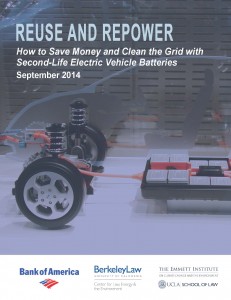A common concern about the “greenness” of electric vehicles is that the batteries have a negative environmental footprint, from manufacturing to disposal. True, batteries have an environmental cost, but it is minimal over the lifecycle of the vehicles compared to the alternative of a petroleum-fueled vehicle (of course, the true alternative of walking, biking or transit is the ideal, if not always practical for most people).
But there is also a huge environmental upside to the battery: the prospect of hundreds of thousands of used, cheap batteries available to bottle surplus renewable energy for later use. As David Roberts on Vox.com described:
In four or five years, the batteries in the roughly one and a quarter million EVs currently on the road are going to start to wane. EV owners will either replace them, or replace the cars entirely.
That means we’ll have a lot of used batteries on our hands — batteries with plenty of life left in them, but which are no longer suitable for EVs. What to do?
 It’s worth reading the article in full for an overview. Or you can see our UC Berkeley/UCLA Law report on the subject back in 2014, Reuse and Repower: How to Save Money and Clean the Grid with Second-Life Electric Vehicle Batteries.
It’s worth reading the article in full for an overview. Or you can see our UC Berkeley/UCLA Law report on the subject back in 2014, Reuse and Repower: How to Save Money and Clean the Grid with Second-Life Electric Vehicle Batteries.
A lot has happened since that report came out, particularly with pilot projects. For example, as the MIT Technology Review reported, BMW combined batteries from 100 cars for a grid-scale energy storage facility in Hamburg, Germany, which is capable of storing 2.8 megawatt-hours of energy and delivering up to two megawatts of power. It’s designed to meet periods of peak demand to avoid having to ramp up fossil-fueled power plants. And a French web hosting company in Normany is deploying used Nissan EV batteries to capture surplus renewables to lower energy costs. These are just a few of the growing number of pilot projects happening around the world.
And studies on the subject are increasingly bullish. Fortune covered a new report this past summer from Bloomberg New Energy Finance, which predicts that roughly a third of electric car batteries are expected be reused by 2025, totaling 29 gigawatt hours of used batteries. 10 gigawatt hours of those could be repackaged for grid needs.
But the challenges are myriad. Greentech Media has a great article describing the barriers and options going forward, many of which we discussed in our 2014 report:
“Batteries are a lot like people: They each have their own individual state of health depending upon what they’ve been exposed to and how they’ve been treated over the course of their life,” said Ken Boyce, who’s developing a safety standard for second life batteries at Underwriters Laboratories, a major safety certification firm.
But despite the potential and progress being made, one major automaker is notably absent in these efforts: Tesla. As the Bloomberg New Energy Finance report author Claire Curry observed in Greenwire [paywalled]:
Tesla, however, is not one of the players, partly because it is more interested in recycling batteries at its Gigafactory in Nevada, Curry said.
“Tesla has so much stationary storage capacity it needs to sell,” she said.
I asked Elon Musk about his interest in used EV batteries in early 2014 at a public event, and he said he was absolutely in favor. His staff later approached me to walk back his comments a bit. It seems that they want to make money selling new batteries and don’t want the competition from cheap used ones.
But Tesla may be swimming against the tide, as a surge in used EV batteries could change the energy storage market and clean the grid for the better — starting in just a few short years.
One thought on “What To Do With Used Electric Vehicle Batteries? Everything.”
-
Pingback: Used EV Batteries — Better To Recycle Than Reuse? | Ethan Elkind
Leave a Reply
You must be logged in to post a comment.


